We are now closed for the Christmas and New Year period, returning on Monday 5th January 2026. Orders placed during this time will be processed upon our return on 5th January.

Legal design is no longer a niche concept but a growing movement reshaping how legal services are delivered, understood, and experienced. While discussions around innovation in law have gained momentum, meaningful adoption often lags behind ambition. Many legal professionals recognize the need for transformation but struggle to integrate a prototype-driven and interdisciplinary approach into their working environments.
This book bridges the gap between theory and execution, offering a comprehensive guide to implementing legal design in law firms, legal departments, institutions, and other legal service environments. From exploring user-centered approaches to structuring design-driven processes, it provides actionable insights into how legal design can enhance clarity, accessibility, and efficiency in legal services.
Drawing on extensive experience in legal design, innovation, and transformation, this book blends strategic vision with hands-on experience. It goes beyond high-level discussions to address the real-world challenges of integrating legal design thinking into legal practice, whether that means overcoming organizational resistance, aligning stakeholders, or proving the value of legal design to decision makers. It also offers practical tools and frameworks to navigate the hidden complexities of legal design projects, ensuring that design-driven change is not only embraced but sustained.
Whether you’re just starting your journey in legal design or already working on innovation projects, this book serves as a practical resource that you can revisit as challenges and opportunities arise. By blending theory with real-world application, it provides a roadmap for making legal design a fundamental and effective part of legal practice.